
Overview
Using stack and reach measurements is any easy way to compare different bicycle frames. Bike manufacturers provide these measurements in frame geometry charts on their websites, for each different model of bicycle they sell. However, you often have to hunt around for these charts which are not as exciting as the marketing claims and imagery. Stack and reach bike comparisons are a great way to determine;
(a) the correct frame size you require when searching for a new bike.
(b) if you can replicate your current setup on another new bike.
(c) if you want to change your setup on another bike ie. you want to have the handle bars higher or lower etc.
Stack and reach frame comparison works best when you know both these measurements of a bike that you ride, with a reasonably accurate setup. This allows you to accurately determine if your current bike position (or a revised position) can be setup on a different frame and what changes are required to achieve it. The stack and reach numbers of your current frame are the key ingredient for that.
Whilst this article might seem quite long and detailed, the principles are actually quite simple. Please have a read through and then try it for yourself. There are plenty of examples at the end comparing frames to help you get the hang of the process.
The Basics of Your Riding Position
Before we delve into frame comparison using stack and reach. We need to quickly cover the 2 most crucial elements of your riding position on a bike. They are;
1. Saddle position.
This is where your saddle is located in relation to the bottom bracket (cranks). Before buying any bike, you need to make sure you can position your saddle in the correct location. Saddle position is fairly specific and is not really going to change much over time. Move the saddle too far out of your sweet spot and it will have a negative impact on your pedalling.
2. Handle bar position.
This is the location of your handle bars in relation to your saddle. You need to be able to comfortably reach the handle bars whilst seated in the optimal position of your saddle. You should be able to hold the drops (lower section of the handle bar) with bent elbows and COMFORTABLY ride in this position. Always setup the bike so you are able to comfortably ride in all 3 positions of the handle bars (tops, hoods and drops).
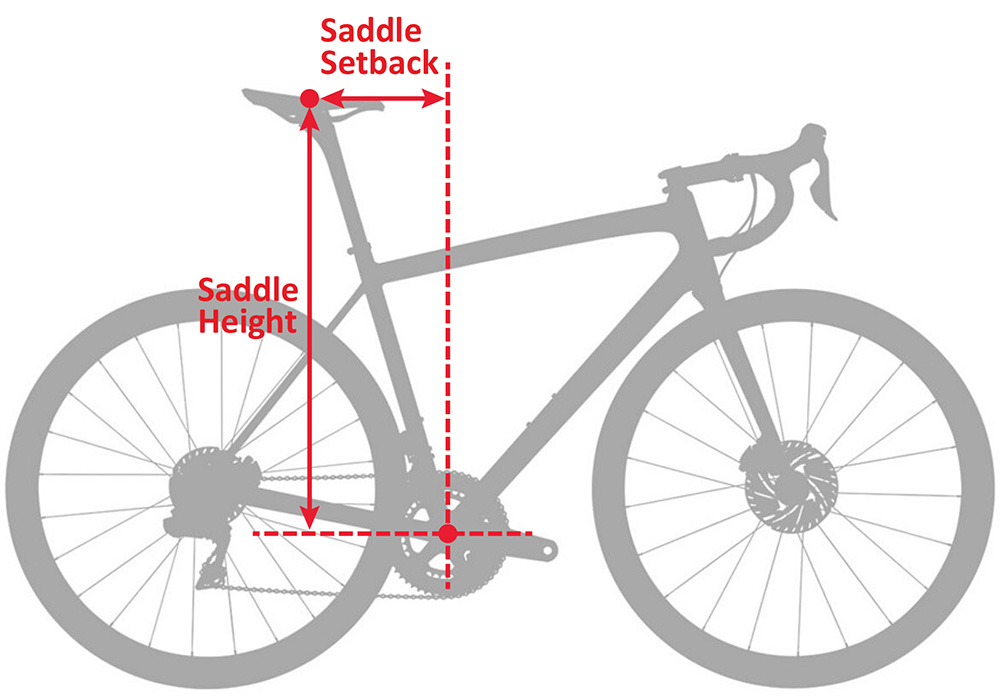
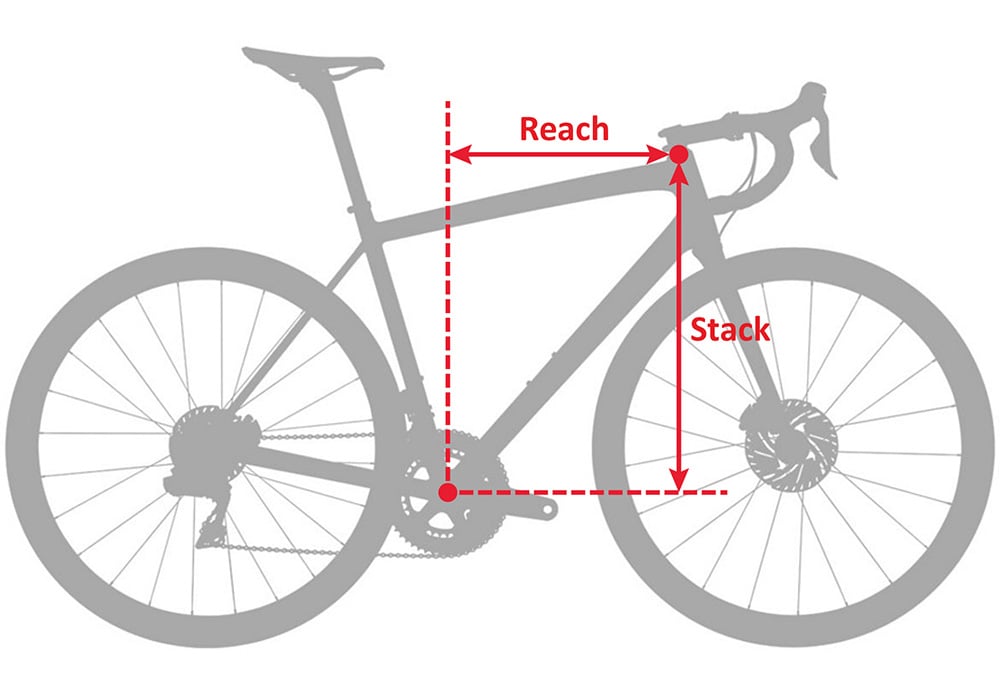
Stack and reach measurements don’t directly provide you with information regarding the location of your saddle or handle bars on a bike, but if you know the stack and reach measurements of a frame that fits you well, these measurements provide a useful way to compare how other frames match the fit of your current bike. Using the stack and reach numbers of a frame, we can accurately estimate if the position of the saddle and handle bars can be replicated on the frames we are comparing.
How Other Components Affect the Fit
Finding the correct frame size is one thing, but you often buy a complete bike, not just a frame. Each bike is supplied with a range of components selected by the manufacturer. Many of these components can change your fit on the bike and need to be considered when you are ready to buy a bike.
- Seat Post. The offset of the seat post can vary, you should check the offset on your old bike.
- Handle bars. The shape and dimensions will change your reach to the hoods and drops.
- Stem. The bike may be supplied with a different stem length and/or angle than what you need.
- Saddle. The sweet spot of the saddle can vary between models and the saddle rail limits can vary.
- Brake/Shift Levers. Where can they be positioned on the handle bars? Does it change the reach?.
- Cranks. The length of the crank arms can vary which may require a small variation to saddle position.
What Information is Required for a Frame Comparison?
To make a comparison between your bike and other frames, you will need;
- The stack and reach measurements of YOUR frame. This can be measured, but it is preferable if you can get the information from the manufacturer’s frame geometry chart. This information is specific to the year and model of your bike. Lookup frame geometry for older bikes. This geometry chart will also specify the angles for the seat tube and head tube.
- If you have the manufacturer’s geometry chart, you also need to know the size of your frame to know which stack and reach measurements to use. Sometimes the frame size is marked on the frame, otherwise, try measuring the length of the head tube, then check on the geometry chart if any frame sizes match that measurement.
- The length of your stem. The stem is measured (centre to centre) if the length is not marked on the stem.
- The height of the spacers fitted below your stem which is easy to measure. Typically it won’t be more than 30 mm.
- The angle of your stem (optional, but also handy). Usually marked on the stem. The angle can be referenced in 2 different ways. eg. 3T may specify their stem has a +/-6 degree angle. Deda on the other hand may specify their stem as 84 degree angle stem (90 – 6 degrees). They have the same angle. Many stems can be flipped and fitted in reverse eg. fitted as either a -6 degree or a +6 degree (riser) stem.
- Offset of your seat post can be handy to know if you want to buy a complete bike. However, this information is rarely mentioned by bike manufacturers in the sales literature. It is now common for many frames to be supplied with a custom seat post that cannot be swapped for a different brand. It is worth comparing the offset of the supplied seat post with your own bike if you are seriously wanting to buy it. Seat post offset typically ranges from 0 mm to 25 mm). Always arrange a fitting in the shop to be completely sure the size is right.

When looking at the manufacturer’s geometry chart, you should note down the following key measurements;
- Frame stack
- Frame reach
- Seat tube angle
- Head tube angle
Do I Need Spacers Under the Stem?
Most of us require spacers fitted under the stem to achieve a comfortable position on a bike. Manufacturers typically manufacture frames with shorter head tubes to provide some amount of handle bar height adjustment so the frame suits the demands of different riders.
Spacers are used to raise the height of your handle bars (if required). Whilst we would all like the look of a ‘slammed’ stem with no spacers under it, that is not very practical if you can’t ride the bike in comfort for the duration of your ride.
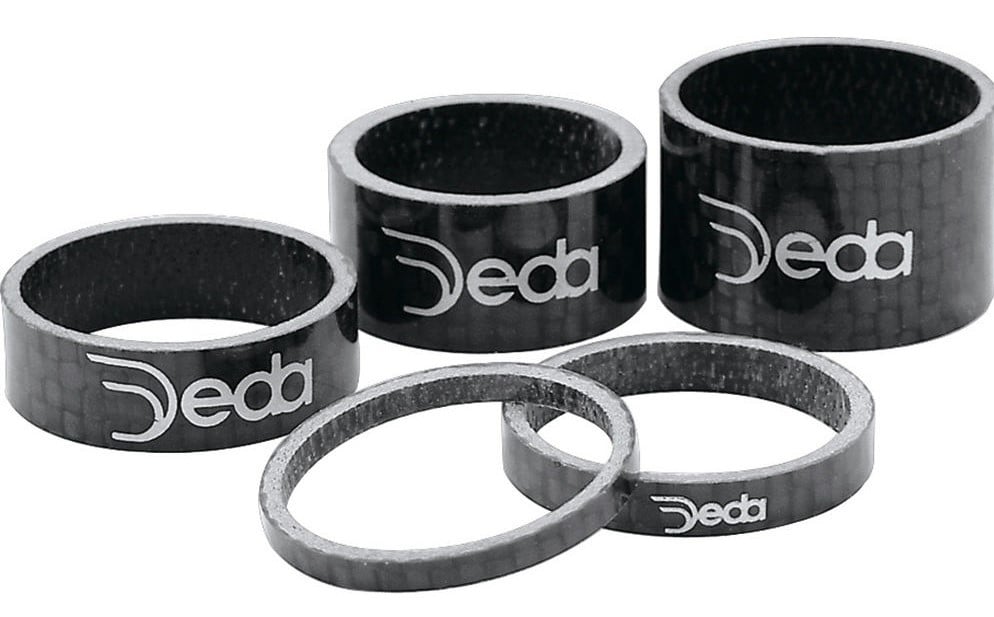
However you can reduce the number (or need) for spacers under your stem if you select a frame that has stack and reach measurements that suit you.
Endurance road bikes have much higher head tubes than race oriented road bikes. A higher head tube reduces the number of spacers required to position the handle bars higher for riders with back issues or poor flexibility.
Spacers also provide a cheap and easy way to fine-tune your riding position without having to change frames. They can also be useful if you need to temporarily change your riding position ie. recovery from injury.
My Recommendations:
1. When determining the number of spacers you need, during a bike fit, test with your hands on the drops of the handle bars as this is the lowest and furthest reach point of the handle bars. You should be able to comfortably reach the drops with bent arms. When the handle bars are at the correct height, riding on the drops will be comfortable and this hand hold offers great control of the bike. If you need more than 30 mm of spacers to ride comfortably on the drops, then I recommend searching for a different bike.
2. If you are concerned about resale, make sure the bike shop cut the fork steerer with 30 mm of spacers fitted and position the spacers you don’t require on top of the stem. It may not look that pretty, but once the fork steerer is cut, you can never add it back again. The next owner may appreciate the extra height without having to fit a fork steerer extension adapter.
3. If you are new to cycling or expect that your riding position is likely to change to a lower handle bar position in time, then choose a frame that requires you to fit about 20 mm of spacers under the stem. This will place you in a comfortable riding position initially. In time those spacers can then be slowly removed to lower your handle bar position as your body adapts to the demands of cycling.
How Do Spacers Affect Stack and Reach Comparisons?
Adding or removing spacers under your stem alters your handle bar position in 2 ways.
- Adding spacers will increase the height of your handle bars. Removing spacers will decrease the height of your handle bars. eg. if you add a 10 mm spacer under your stem, your handle bars be raised ALMOST 10 mm higher. I say almost because due to the angle of head tube and your stem, you may not get the full increase or reduction in height, but for the purposes of a quick stack and reach frame comparison, you can ignore this small variation.
- Adding one 10 mm spacer under your stem will also REDUCE the reach to your handle bars from the saddle by approximately 2 to 3 mm. Similarly removing spacers will INCREASE the reach to the handle bars by 2 to 3 mm. This is due to the head tube being angled back toward the saddle. The table below shows the difference in reach based on a 73.5 degree head tube fitted with a 120 mm long stem that has a -8 degree angle.
| Spacer Height | Actual Stem Length | Effective Stem Length |
|---|---|---|
| 0 mm | 120 mm | 120 mm |
| 10 mm | 120 mm | 117 mm |
| 20 mm | 120 mm | 114 mm |
| 30 mm | 120 mm | 111 mm |

Note: Even if you have no spacers fitted under the stem, fitting a 120 mm long stem may not increase the reach to your handle bars by exactly 120 mm. This is again due to the angle of your head tube and stem. For the purposes of a quick stack and reach frame comparison, you can also ignore this small variation.
Which Bike I am Using for Comparison?
In this article, I will be comparing the riding position of my 2014 Cervelo R5 with a selection of modern bikes to determine the following;
- Can I can match my current saddle and handle bar position on each alternative bike.
- Which frame size would I require.
- Do I need a different stem length / angle
- How many spacers will I need under the stem.

I have ridden just over 50,000 km’s over the past 7 years on the R5 and feel like I have nearly perfected my position on this frame.
When Cervelo released this R5 road bike in 2014, the company came under some criticism for making the frame stack too high for a professional level race bike. Cervelo realised that whilst the bike was oriented for high level racing, it’s the general public whom actually buy the bikes and typically they need to fit a large stack of spacers under the stem to raise the handle bars to a comfortable height.
This design philosophy really suited me as I didn’t want a large stack of spacers under the stem. The higher stack of this frame will become more evident when we start comparing it to some of the best high performance road bikes of 2021. For me, the stack and reach of the 2014 Cervelo R5 sits nicely between aggressive race geometry and upright endurance bike geometry.
Setup of my 2014 Cervelo R5 (size 56)
Originally my R5 was fitted with a 100 mm (-6 degree) stem and no spacers under the stem. However over time I have changed the position by fitting a 120 mm (-8 degree) stem and 10 mm of spacers under the stem.
The FSA seat post supplied with my Cervelo R5 has an offset of 25 mm. I believe that is a fairly standard offset for a road bike. If the bike I was comparing had an IDENTICAL seat post angle, but the seat post offset on the new bike were reduced to 20 mm, then I would need to move the saddle back 5mm on the rails to to match my existing saddle position.
The Bikes I am Comparing
Let’s imagine that I just WON the lottery and was going to buy a brand new, top level road bike. Which modern road bike(s) would I buy? To assess the suitable candidates, I need to investigate which bikes will allow me to replicate my current riding position. Using a stack and reach comparison is a quick, easy and accurate way to do this and I have provided lots of examples below to explain the process.
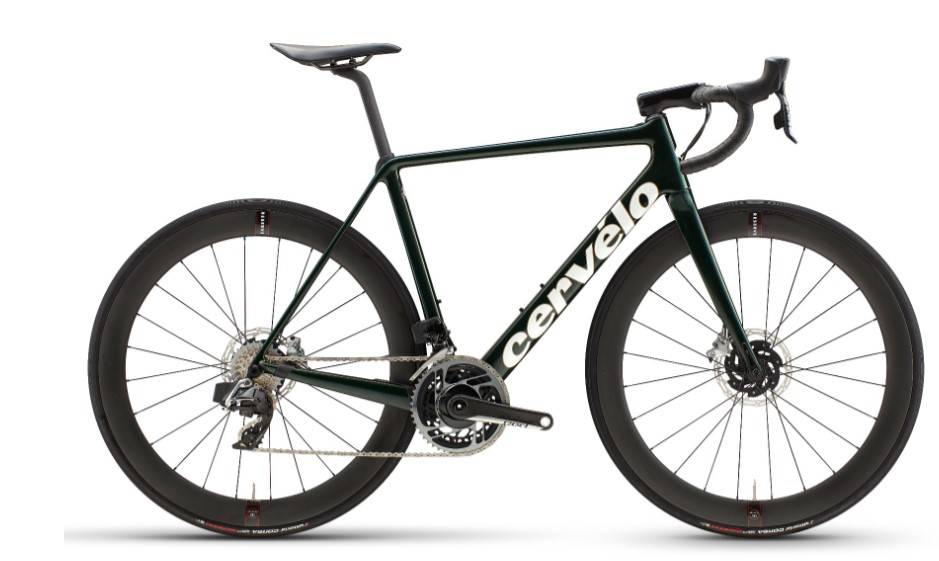
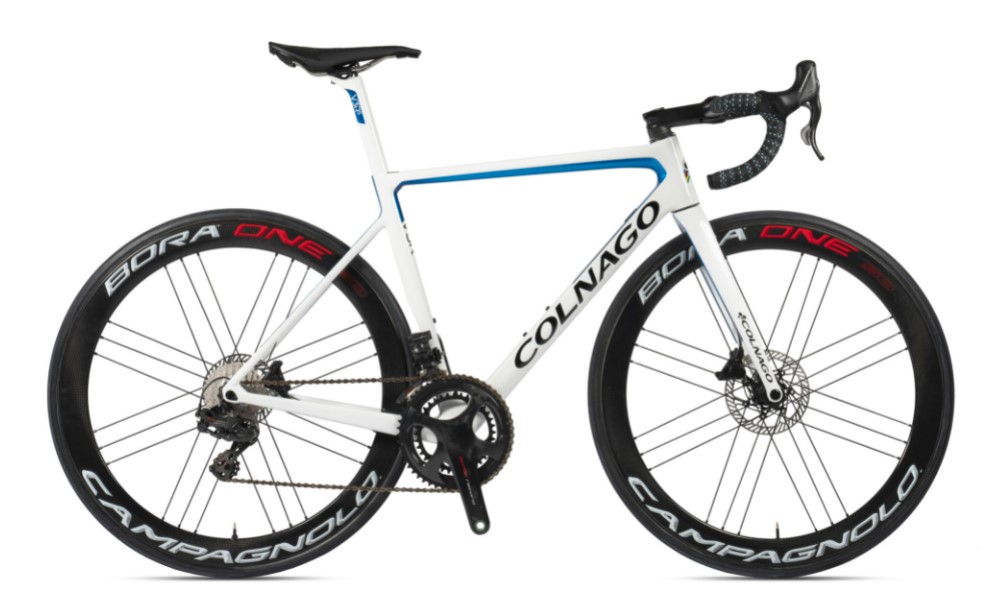

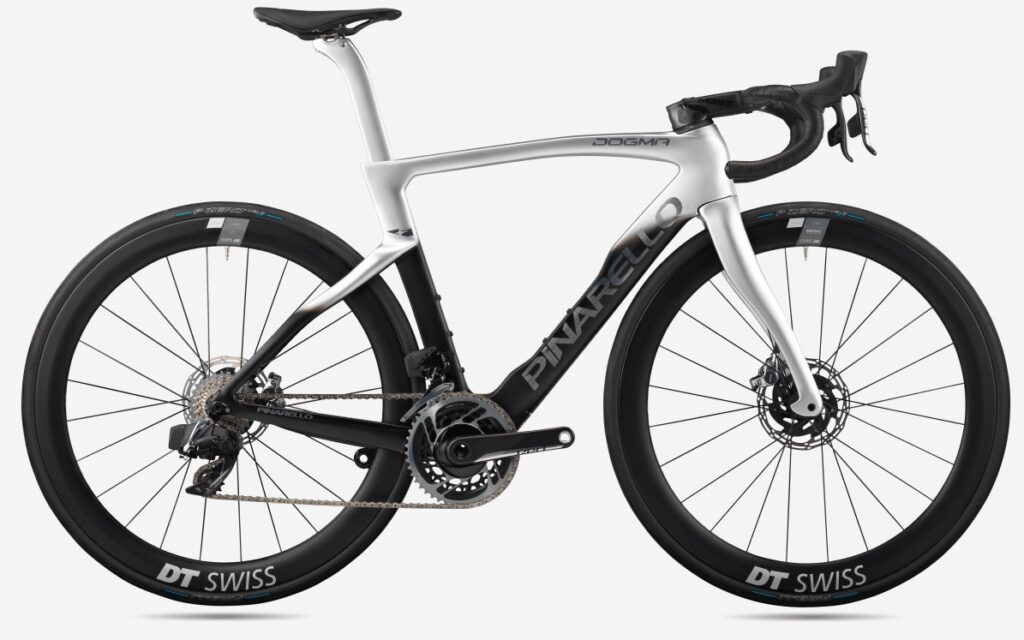

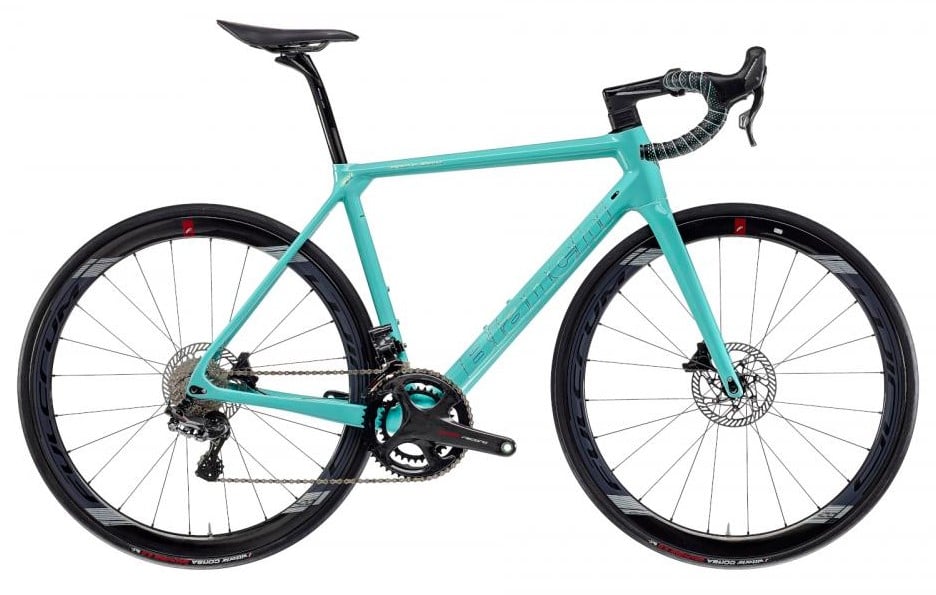
The list of amazing bikes I have selected to compare are;
- Cervelo R5 (2020 version)
- Colnago V3RS
- Specialized Tarmac SL7
- Pinarello Dogma F
- Wilier Filante
- Bianchi Specialissima
- Bianchi Infinito (Endurance)
1. Cervelo R5 (2020) Comparison
I decided to start with a comparison between my R5 and the new R5 which replaced it around 2018. How much have Cervelo changed the geometry? Can I setup my position on the new R5? What changes are required? I will cover this bike comparison in a little more detail than the other bikes, but the same principles apply.


Frame Geometry Specifications Table (in mm)
Frame | Frame Size | Frame Stack | Frame Reach | Head Tube Angle | Seat Tube Angle |
|---|---|---|---|---|---|
| R5 (2014) | 56 | 580 | 387 | 73.5 | 73 |
| R5 (2020) | 56 | 572 | 389 | 73 | 73 |
Frame comparison (in detail):
1. I visited Cervelo’s website to get the 2020 Cervelo R5 geometry chart and then selected the frame size that most closely matches the stack and reach figures of my old R5. Not surprisingly, it was still a size 56 frame that was the closest match.
2. Looking at my table above, we can see that the stack and reach measurements are not too dissimilar from my original bike. As these numbers are very similar, I know that it will be easy to setup my current position on the new R5.
3. The stack measurement of the new R5 is 572 mm. This is 8 mm lower than my old R5 (580 mm). So to position the handle bars at the same height on the new R5, I would need to add about 8 mm of extra spacers under the stem. Remember that I currently have 10 mm of spacers under the stem of my old R5, so I need to fit 18 mm of spacers (which would probably be rounded up to 20 mm) under the stem of the new R5. That’s a reasonable spacer stack on a road bike.
4. The reach measurement of the new R5 is 389 mm. This is only 2 mm longer than my old R5 (387 mm). But as I will be adding an extra 10 mm of spacers under the stem, handle bars shift back about 3 mm closer to the saddle due to the angle of the head tube (as mentioned earlier in this article). I could use the same 120 mm -8 degree stem on the new R5 and probably not even notice any difference.
5. Comparing the head tube angle of both frames we can see the new R5 has head tube angle of 73 degrees and the old R5 has a slightly steeper head tube angle of 73.5 degrees. This means that the new R5 head tube angle is slightly more relaxed (by 0.5 degrees). A reduction in head tube angle means the handle bars are positioned slightly closer to the saddle and this reduces the reach to the bars by a small amount. After taking all this into account, the handle bars may be slightly closer to the saddle on the new R5, but the difference is small.
6. Finally we need to compare the seat tube angle of both frames to assess if it is possible to setup the saddle in the correct position. Both bikes have an identical seat tube angle which makes this comparison simple. I should be able to setup an identical saddle position on the new R5 assuming the offset of the seat post on the new R5 is 25mm or similar. As the seat post on the new R5 is specific to the frame, if the offset were different to my current offset of 25 mm, I would need to investigate my saddle position further before buying the bike. Always test your position on the actual bike before buying it where possible. Finally a bike fit should be used to fine-tune your fit on the new bike.
Bike Comparison Summary:
There would be no problem setting up my position on the 2020 Cervelo R5. I would need to add about 10 mm of spacers, but otherwise the fit would be very similar using the same stem as my old R5.
2. Colnago V3RS Comparison
When Colnago released the V3RS in 2019, I feel this bike flew under the radar a bit for me. Whilst it was definitely a modern and light race bike, I was always more drawn to Colnago’s C60 & C64 lugged carbon frames which are still made in Italy.
Fast forward to the 2020 Tour de France when Tadej Pogacar rode the V3RS up the final 6 km climb of La Planche des Belles Filles and moved into the overall race lead, only to win the TDF the following day. Who will forget that spectacle? 10 months later at the 2021 Tour de France, Pogacar wins again on the V3RS. This time with a commanding lead of 5 minutes and 20 seconds over the runner-up on a Cervelo.
So the V3RS has been ridden to victory in 2 consecutive Tours de France. That is a big deal for any bike manufacturer and would definitely have upset Pinarello. I’m guessing sales of the Colnago V3RS have increased! I would like to own one myself, but first I need to see if I can replicate my position on a Colnago V3RS.


Frame Geometry Specifications Table (in mm)
Frame | Frame Size | Frame Stack | Frame Reach | Head Tube Angle | Seat Tube Angle |
|---|---|---|---|---|---|
| R5 (2014) | 56 | 580 | 387 | 73.5 | 73 |
| V3RS | 54s | 578 | 390 | 72.5 | 73.1 |
Frame comparison:
1. Looking at the frame geometry charts, the V3RS size 54s frame was a really close match to the stack and reach figures of my Cervelo, so I already know it is possible to re-create my setup on this bike. Cool!
2. Comparing the stack of both frames we can see the stack of the V3RS is 2 mm lower than my R5. I currently have 10 mm of spacers under the stem of my R5, so I could increase that to 12 mm on the V3RS, but in reality, I doubt I would notice the 2mm difference. I would probably stay with a 10 mm spacer stack on the V3RS.
3. Comparing the reach of both frames we can see the reach of the V3RS is 3 mm longer than my R5, but the head tube angle is 1 degree more relaxed (72.5 degrees). This reduction in head tube angle moves the handle bars closer to the saddle by a small amount. This rearward shift would cancel out some of the extra 3 mm reach on this frame. I could probably continue to use a 120 mm stem fitted on the V3RS. There is also the option of fitting a 120 mm stem with a -6 degree angle instead of the -8 degree angle. This 2 degree reduction in stem angle will raise the handle bars slightly to possibly cancel the 2 mm stack difference.
4. Finally we need to look at the seat tube angle. Both bikes have a NEARLY identical seat tube angle. Setting up the same saddle position will be easy on the V3RS. The V3RS has a very slightly steeper seat tube angle which would position the saddle clamp bolt closer to the bars. If anything, I might need to slide the saddle just slightly further back from the bars. I also need to consider the offset of the seat post supplied with the frame. This seat post is specific to the frame, so if the offset were different to my current offset of 25 mm, I would need to investigate my saddle position further.
Bike Comparison Summary:
There would be no problem setting up my position on the Colnago V3RS with the same 10 mm spacer stack. I would probably swap to the special Colnago stem which allows you to route the cables internally. This stem is available in a 120 mm -6 degree which would suit me perfectly I expect.
3. Specialized Tarmac SL7 Comparison
A high end road bike comparison wouldn’t be complete without including the Specialized Tarmac. Previously the Tarmac was marketed as a light weight climbing bike, but Specialized changed the design brief of the Tarmac SL7 to an all-round lightweight aero bike. Interestingly this change in direction validates Pinarello’s development strategy for the Dogma F series over the past 6 year. They just wanted to make one great all-round road bike instead of 2 different bikes (one aero, one light).
Throughout the years, the Tarmac has been ridden to victory in every major professional race. But in recent years, Pinarello, Colnago and Bianchi have been the beneficiaries of overall grand tour wins. However, this is not a reflection on the capabilities of the bike, as it is fast up climbs (Julian Alaphilipe), fast in the sprints (Mark Cavendish) and super quick everywhere else (Sagan, Asgreen, Van der Breggen). Definitely a bike I would like to own, but does it fit me?


Frame Geometry Specifications Table (in mm)
Frame | Frame Size | Frame Stack | Frame Reach | Head Tube Angle | Seat Tube Angle |
|---|---|---|---|---|---|
| R5 (2014) | 56 | 580 | 387 | 73.5 | 73 |
| Tarmac SL7 | 56 | 555 | 398 | 73.5 | 73.5 |
| Tarmac SL7 | 58 | 581 | 405 | 73.5 | 73.5 |
Frame comparison:
Looking at the geometry chart for the Tarmac SL7, I decided to include 2 frames sizes for the comparison. Comparing my Cervelo with the Tarmac SL7 size 56 frame, the stack of the SL7 is 25 mm lower and the reach is 11 mm longer. This firmly places the SL7 in the aggressive race geometry category (in my opinion). The size 58 frame has nearly an identical stack as the Cervelo, but the reach is 18 mm longer.
Just looking at these variations, I can tell the bike is not really suited to my riding position. Both frame setups require a compromise to fit my position. The reach of the size 58 could be solved by fitting a 100 mm stem, but that would look ridiculous on such a large frame. So let’s look at what is required to setup my position on the size 56 frame instead;
- Increase the spacer stack by 20 mm (from 10 mm to 30 mm). Now the handle bars are just 5 mm lower on the Tarmac size 56. I could change from a -8 degree stem to a -6 degree stem to raise the handle bars by a few more millimetres. I could also invert the stem to use as a riser stem to move the handle bars higher and reduce spacers, but that’s just not the look I want on my road bike.
- Looking at the difference in reach of 11 mm for the size 56 frame, by adding 20 mm of spacers, I have reduced the reach to the handle bars by about 6 mm. I could also reduce the angle of the 120 mm stem from -8 degrees to -6 degrees to further reduce that 5 mm difference. Worst case I could fit a 110 mm stem instead which is quite a reasonable stem length for a size 56 frame.
- The head tube angle of both bikes is the same at 73.5 degrees, so no additional adjustments there.
- The seat tube angle of the Tarmac is slightly more upright (0.5 degrees) than the Cervelo, so there should be no problem setting up my saddle position on the Tarmac, but we do need to consider the offset of the seat post supplied with the frame. This seat post is specific to the frame, so if the offset were different to my current offset of 25 mm, I would need to investigate my saddle position further.
Bike Comparison Summary:
The size 56 frame would need 30 mm of spacers and possibly a 110 mm stem., but I’m not really sure I would be happy with the aesthetics of that setup. I would prefer a frame that doesn’t require me to ride at the upper limit of the spacer stack. Not a great match unfortunately.
4. Pinarello Dogma F Comparison
The Pinarello Dogma F is the newest frame in the Dogma line-up. It was unveiled just prior to the 2021 Tour de France and ridden to a third place overall by Richard Carpaz. Just weeks later he won the Tokyo Olympics road race on the Dogma F. I’m sure Pinarello have probably been frustrated not winning the overall classification of the Tour de France for the past 2 years, when they were dominating the race in the years prior to 2020. But, winning a gold medal in the Olympic road race is a nice consolation prize. In addition the bike also won Paris Roubaix in 2022 which is a nice addition to any palmares.
I think the Dogma F frameset is probably the most expensive in this comparison and certainly has unique aesthetic which I really like. My biggest gripe is that Pinarello update the Dogma frame approximately every 2 years. Great for innovation, but not so good for resale value. Since they released the Dogma F8 in 2015 (6 years ago), there have been 3 updates (F10, F12 and now the Dogma F). A lot of other manufacturers work on a 3 year update cycle. But if I just won the lotto, I probably wouldn’t care about spending the USD 16,500. I would just need to buy it now to get a full 2 years of owning the newest bike, that’s if you could actually get one!
But is the frame suitable for my riding position?


Frame Geometry Specifications Table (in mm)
Frame | Frame Size | Frame Stack | Frame Reach | Head Tube Angle | Seat Tube Angle |
|---|---|---|---|---|---|
| R5 (2014) | 56 | 580 | 387 | 73.5 | 73 |
| Dogma F | 560 | 570.2 | 390.7 | 73.2 | 73 |
Note: Unfortunately, Pinarello’s geometry chart doesn’t seem to make a clear mention of frame sizes, however I read online that they size their frames using the centre-to-centre measurement of the seat tube. This measurement is 560 mm for the frame size I have selected. Typically bike manufacturers size their frames using the effective top tube length, rather than the seat tube length. The effective top tube length of my Cervelo is 565 mm and they don’t mention the length of the seat tube in the 2014 R5 geometry chart.
Frame comparison:
The Dogma F has a shorter stack by 9.8 mm and a slightly longer reach of 3.7 mm, so it is not as aggressive as the Tarmac SL7. Still, some changes need to be made to setup my position on the Dogma F. The Dogma F is designed for use with the Most Talon Ultra Light integrated bar and stem which features a -6 degree angle. Here are the changes required to setup my position on the Dogma F.
- I could increase the spacer stack by about 10 mm (from 10 mm to 20 mm) on the Dogma F. This raises the handle bars by about 10mm thereby cancelling out the difference in frame stack of 9.8mm. Now the bars are at a similar height to my R5. The extra 3.7 mm of reach would mostly be eliminated having added an extra 10mm of spacers.
- The head tube angle of both bikes are NEARLY identical, so no additional adjustments there.
- The seat tube angle of the Dogma F is identical to the Cervelo, so there should be no problem setting up my saddle position. I would just need to consider the offset of the seat post supplied with the frame. This seat post is specific to the frame, so if the offset were different to my current offset of 25 mm, I would need to investigate my saddle position further.
Bike Comparison Summary:
The size 560 Dogma F frame could be easily setup to match my position on the Cervelo by either fitting 20 mm of spacers under the stem or reducing stem length to 110 mm. A surprisingly simple change and worthy of a test ride for sure.
5. Wilier Filante Comparison
Wilier have been making bicycles since the eary 1900’s. Here’s an interesting fact I read on Wikipedia. The company name Wilier is actually an acronym for the Italian phrase “W l’Italia liberata e redenta”, where the W is an abbreviation for “Viva!” and it means Long live Italy, liberated and redeemed.
I included the Filante in this list of desirably bikes as it is a great example of form combined with function. It’s a lightweight all-round aero bike with a lovely modern aesthetic. Beautiful velvet red paint work, but I would have preferred the branding in white instead of black. Reading some reviews it is also supposed to have a smooth ride quality which is something I really appreciate in a good bike.
The Filante is supplied with a one piece handle bar stem combo, so you don’t have the same variety of stem lengths & angles. Wilier produced an AccuFit table to help you determine which frame size, bar and spacer combination you require based on handle bar stack and reach to get the right fit. So I will make the comparison using stack and reach as well as their Accufit table.


Frame Geometry Specifications Table (in mm)
Frame | Frame Size | Frame Stack | Frame Reach | Head Tube Angle | Seat Tube Angle |
|---|---|---|---|---|---|
| R5 (2014) | 56 | 580 | 387 | 73.5 | 73 |
| Filante | L | 555 | 391 | 73 | 73.5 |
| Filante | XL | 571 | 395 | 73 | 73 |
Frame comparison using my method:
Like the Tarmac SL7, the Filante has aggressive race geometry. I have included 2 frame sizes to highlight the fit differences. Looking at the stack height of the Filante size L frame, it is an ultra low 555 mm. This is 25 mm lower than the stack height of Cervelo (for which I already use 10 mm of spacers). I would need 35 mm of spacers on the Filante which apparently is possible, is not my preference. Therefore I will do the comparison using the size XL frame which is 9 mm lower stack and 8 mm more reach. Lets see what I need to change to setup my position on the Filante.
- I need to increase the spacer stack by 9 mm (from 10 mm to 19 mm, lets say 20 mm) of spacers under the stem.
- The extra 8 mm of reach would be reduced by 3 mm as I have added 10 mm of spacers. The slightly more relaxed head tube would also reduce some of the 5 mm difference that remains.
- The seat tube angle of the size XL Filante is identical to the Cervelo, so there should be no problem setting up my saddle position. I would just need to consider the offset of the seat post supplied with the frame. This seat post is specific to the frame, so if the offset were different to my current offset of 25 mm, I would need to investigate my saddle position further.
Frame Comparison using Wilier’s Accufit Table:
Wilier’s Accufit system uses handle bar stack and reach measurements (measured from bottom bracket to the centre of the handle bars), rather than frame stack and reach measurements to determine the best fit. Their method takes into account differences in the head tube & stem angle, stem length and spacer height. It works well because they only provide a fixed number of combo bar/stem options. It wouldn’t really work if you could choose your own stem as they are available in a multitude of lengths and angles.
I measured the handle bar stack and reach of my Cervelo in order to work out what setup the Wilier Accufit recommended for me. The following table contains the measurements of my Cervelo and an extract from Wilier’s Accufit table of possible matching configurations.
| Description | Stem Length | Spacer Stack | Handle Bar Stack | Handle Bar Reach |
|---|---|---|---|---|
| My Cervelo R5 | 120 | 10 | 634 | 493 |
| Filante (size XL) | 114 | 15 | 633 | 495 |
| Filante (size XL) | 114 | 20 | 638 | 493 |
You can see in the above table that based on my measurements of the Cervelo, I was recommended to use a size XL frame and fit a 114 mm stem/bar combo with 2 possible spacer stack heights;
- Fit 15 mm of spacers under the stem. Looking at the handle bar reach & stack figures, it’s a close match with the handle bars 1 mm lower and 2 mm further away from the saddle on the Filante.
- Fit 20 mm of spacers under the stem. Looking at the handle bar reach & stack figures, again a very close match with the handle bars 4 mm higher, but exactly the same reach from the saddle on the Filante.
The measurements of the handle bar stack & reach on my Cervelo are possibly a few millimeters out, but comparing against Wilier’s Accufit system illustrates that comparing frames using regular frame stack and reach is quite effective and works across all manufacturers.
Using frame stack and reach, I was able to accurately pick the Filante XL frame size and expect to fit about 20 mm of spacers under the stem. I also knew the stem may need to be a little shorter. The XL frame has an effective top tube of 57 cm which is only slightly longer than the 56.5 cm I currently ride. It would be interesting to see how this riding position feels as it is only marginally different.
6. Bianchi Specialissima (2021) Comparison
Bianchi are the world’s oldest bicycle manufacturer in existence according to Wikipedia. The first Bianchi Specialissima road bike was released in 1956, back in the days of steel frames. It was painted in the traditional Celeste colour.
In 2016, Bianchi revived the name ‘Specialissima’ for a new carbon fibre road bike. It has since been updated and this brand new 2021 Specialissima is a lightweight climbing bike with improved aerodynamics. For many years now Bianchi have been adding Counterveil technology to their carbon frames which is designed to absorb vibrations from the road. I haven’t ridden a Bianchi, so it would be interesting to see how effective this technology actually is.
The Specialissima is a nice modern adaptation of a traditional road bike frame, but can I replicate my setup on this lovely frame?


Frame Geometry Specifications Table (in mm)
Frame | Frame Size | Frame Stack | Frame Reach | Head Tube Angle | Seat Tube Angle |
|---|---|---|---|---|---|
| R5 (2014) | 56 | 580 | 387 | 73.5 | 73 |
| Specialissima | 570 | 556 | 395 | 73 | 73.5 |
| Specialissima | 590 | 575 | 398 | 73 | 73 |
Frame comparison:
I have again listed two frame sizes as the Specialissima frame geometry is also aggressive. Looking at the stack height of the Specialissima size 570 frame, it is an ultra low 556 mm. This is 24 mm lower than the stack height of Cervelo (for which I already use 10 mm of spacers). I would need 34 mm of spacers on the Specialissima which is not ideal. This frame has an effective top tube length of 56 cm which is close to my Cervelo. I can tell that this frame is NOT suitable for my riding position. I would need to size up to the larger 590 frame, which is sold with a 120 mm stem and then reduce that stem to a shorter 110 mm stem. I probably wouldn’t go with this bike.
6. Bianchi Infinito Comparison
As the Specialissima is not suitable, I decided to include a comparison with Bianchi’s Infinito, which is designed with their endurance road geometry. I should mention at this point that Bianchi’s road endurance geometry is more like some other manufacturer’s normal road geometry. The Infinito is designed for long rides, a more upright position and also has the Counterveil vibration absorption technology. The frame is more angular like the Oltre XR bikes. The Infinito is only sold with second tier group sets eg. Ultegra etc. so it is a better value for money proposition. What frame size would I need?
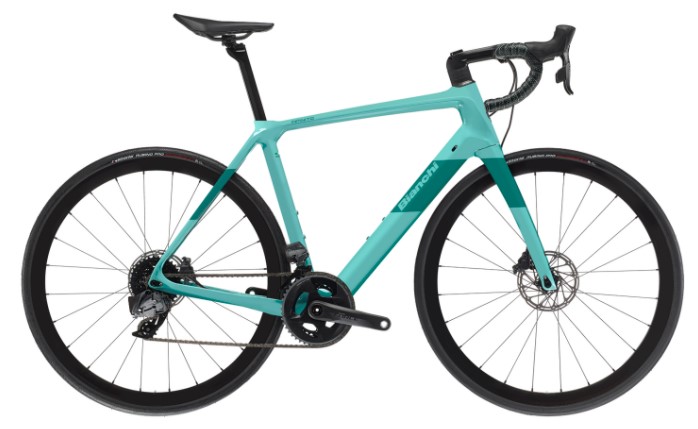

Frame Geometry Specifications Table (in mm)
Frame | Frame Size | Frame Stack | Frame Reach | Head Tube Angle | Seat Tube Angle |
|---|---|---|---|---|---|
| R5 (2014) | 56 | 580 | 387 | 73.5 | 73 |
| Infinito | 550 | 569 | 381 | 72 | 73.5 |
| Infinito | 570 | 585 | 386 | 72.5 | 73.5 |
Frame comparison:
Instantly you can see a big difference in stack height and reach when comparing the Infinito with the Specialissima. On the Infinito, I could ride either the size 550 or the size 570. Let’s compare both options;
- The size 550 frame is one size smaller than what I would typically ride (56 cm). I would need to have a 20 mm spacer stack (10 mm more than the Cervelo). The reach of this frame is 6 mm less than the Cervelo. Also, having added 10 mm of spacers has moved the handle bars about 3 mm closer to the saddle, so I would most likely need a 130 mm stem to match the reach on the Cervelo.
- The size 570 is the only frame in this comparison that has a higher stack than the Cervelo. I could reduce my spacer height by 5 mm (from 10 mm to 5 mm). This small reduction moves the handle bars 1 to 2 mm close to the saddle.
- The head tube of the Infinito is more relaxed than the Cervelo (by 1 degree). If there were a lot of spacers fitted under the stem, the handle bars would be positioned even closer to the saddle, but as I am only using 5 mm of spacers, the reduced head tube angle doesn’t affect the position of the bars much at all. This is because the stem is almost resting on the top of the head tube (where the reach measurement is taken from).
- The reach is only 1 mm less than the Cervelo, so I could use the same 120 mm stem.
- Finally we need to look at the seat tube angle. The Infinito has a slightly steeper seat tube angle which would position the saddle clamp closer to the bars. If anything, I might need to slide the saddle just slightly further back (from the bars). We also need to consider the offset of the seat post supplied with the frame. If the seat post offset were different to my current offset of 25 mm, I would need to investigate my saddle position further.
The only problem with having a small spacer stack (or no spacers) under the stem is that you don’t have as much ability to position the handle bars lower should you want to go lower over time. You would either need to resort to a more extreme -17 degree angle stem, or if that doesn’t get you low enough, you’d need to buy a different frame (or bike). I don’t expect my position to go any lower as I am not getting any younger, so it is fine for me to have a small spacer fitted under the stem.
Summary
You can see there is quite a variety in frame geometry and frame size labeling between manufacturers. Whilst my riding position is not suited to all these bikes, there are still some great options that would easily fit my position including the 2020 Cervelo R5, Colnago V3RS and Pinarello Dogma F. I would be less likely to go with the Specialized Tarmac SL7 and Wilier Filante and Bianchi Specialissima. The Bianchi Infinito is a good fit, but doesn’t quite fit into this best of the best road bike comparison.



There are some notable exceptions ie. Trek, Ridley, Giant etc. but thsi article was long enough already. You can enjoy the challenge of comparing those frames for yourself. You should have a good idea how it works now.
I hope this guide has been of some help in explaining how you can use stack and reach measurements to compare bikes across manufacturers with your own setup. I have used this system quite successfully, particularly when selecting a rental bike size when ordering rental bikes to ride on overseas holidays. It is certainly a quick way of assessing the right frame size and what changes are required to fit your position.
Useful Tools
Here are some useful online resources;
- Lookup frame geometry charts for bikes: https://geometrygeeks.bike/
- Change and Compare measurements on a bike frame: https://www.bikegeocalc.com/
About Me.
I have been riding and working on my own bikes for many years now. I wanted to share my experiences, knowledge and research with others. My aim is to inspire people to get involved in all aspects of this amazing sport. Cheers.
Comments.
I welcome reader feedback in the comments section. Should you wish to suggest an amendment, please include a note advising the source of your information so that myself and other readers can ascertain the accuracy of your information. Note: Trolling or argumentative comments will be removed as they are counter-productive.